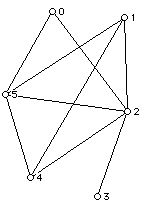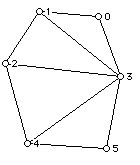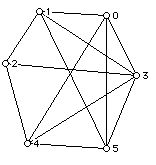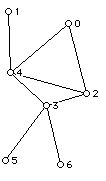
Geometric Structures: Induced Subgraphs
Prepared by:
Joseph Malkevitch
Department of Mathematics
York College (CUNY)
Jamaica, New York 11451
email:
malkevitch@york.cuny.edu
web page:
http://york.cuny.edu/~malk/
Somewhat unexpectedly, the following idea turns out to be important not only in generating subgraphs from a given graph, but also for finding conditions that a family of graphs obey a particular property.
Definition:
Given a graph G, and a set of vertices W which is a subset of V, the vertex set of G, the subgraph W' of G induced by the set W is the graph consisting of the set of vertices W, where two vertices in W are joined when they are already joined in G. (Sometimes one says that the subgraph W' is generated by the set of vertices W.)
Example:

For the set of vertices W = {1, 4, 3} the induced subgraph is:

Note that though we started with a labeled graph the induced subgraph is treated as an unlabeled object.
For the set W = {1, 2, 4, 3} the induced subgraph would be:

1. For each of the graph shown below:
a. Find the subgraph induced by the set W = {0, 1, 2, 3 }
b. Is the cycle of length 4 an induced subgraph? (If so, what set W of vertices does the job?) (What is required is finding a set of vertices W in the graph such that W induces a cycle of length 4.)
c. Is the complete graph on 4 vertices an induced subgraph? (If so, what set W of vertices does the job?)
d. Is the path of length 4 an induced subgraph of? (If so, what set W of vertices does the job?)
e. Find all the different (e.g. non-isomorphic) graphs which are induced by sets W with 3 elements.
f. Find the longest length path induced in each graph.
g. Find the longest length cycle induced in each graph.
i. Is graph G planar?
j. Can you find a plane drawing of graph L?
G


L



